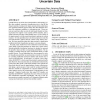Free Online Productivity Tools
i2Speak
i2Symbol
i2OCR
iTex2Img
iWeb2Print
iWeb2Shot
i2Type
iPdf2Split
iPdf2Merge
i2Bopomofo
i2Arabic
i2Style
i2Image
i2PDF
iLatex2Rtf
Sci2ools
KDD
2010
ACM
2010
ACM
Direct mining of discriminative patterns for classifying uncertain data
Classification is one of the most essential tasks in data mining. Unlike other methods, associative classification tries to find all the frequent patterns existing in the input categorical data satisfying a user-specified minimum support and/or other discrimination measures like minimum confidence or information-gain. Those patterns are used later either as rules for rule-based classifier or training features for support vector machine (SVM) classifier, after a feature selection procedure which usually tries to cover as many as the input instances with the most discriminative patterns in various manners. Several algorithms have also been proposed to mine the most discriminative patterns directly without costly feature selection. Previous empirical results show that associative classification could provide better classification accuracy over many datasets. Recently, many studies have been conducted on uncertain data, where fields of uncertain attributes no longer have certain...
| Added | 15 Aug 2010 |
| Updated | 15 Aug 2010 |
| Type | Conference |
| Year | 2010 |
| Where | KDD |
| Authors | Chuancong Gao, Jianyong Wang |
Comments (0)

